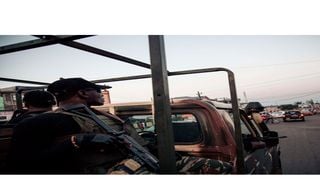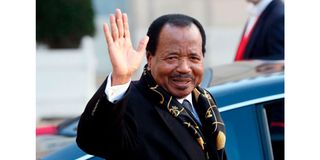
Soldiers of the 21st Motorized Infantry Brigade patrol in the streets of Buea, South-West Region of Cameroon on April 26, 2018. A social crisis that began in November 2016 has turned into armed conflict as separists demand the independence of the English-speaking regions of Cameroon, bordering Nigeria.
|News
Prime
Africa’s forgotten war: How the world moved on from Cameroon killings
What you need to know:
- The violence began in 2016 after separatists wanting to break away from majority French-speaking Cameroon launched a war on government forces.
- A tally by a rights lobby indicateS that by end of 2022, at least 4,000 civilians had been killed by both government forces and armed separatist fighters.
In Cameroon, it is either a stable peaceful country or one where deaths are covered up. It depends on who you ask. But survivors have had their horrid tales for the last seven years, all in which the conflict in the country’s Anglophone region has, sort of, been forgotten by the world.
Last week, opposition politician Evaristus Njong, MP for Boyo, North West region, shocked parliament when he claimed 48 people had been killed in one incident in November alone. Those deaths were not isolated, as it has become routine since 2017, survivors say.
On one a peaceful night on November 6 in Egbekaw village, Cameroon’s South West region, Martha* and her two children were fast asleep. Then, the deafening sound of a gunshot awoke them crudely.
“It was about 3 am when we heard gunshots. We thought it was going to be normal gunshots that we hear often,” she said, asking that we use only her first name to protect her identity. “It didn’t take long before they broke into my house. They were asking, “who else is here, who is here?” Martha recalled in an interview recently.
The violence here began in late 2016 after separatists wanting to break away from majority French-speaking Cameroon and form an independent English-speaking country, launched a war on government forces in the two regions. Since then, it has morphed to violence against unarmed civilians like Martha.
“One of the gunmen told the man holding the gun next to me to shoot or else pass it over to him. Then another of the men came forward to grab the gun and ordered that I leave immediately with the children. That is how we escaped into the bush for safety,” Martha explained.
Matha’s husband was shot on the head and died.
When Martha and her kids came back from their hiding place, their home had been reduced to rubble, a scorch-earth style often employed in this war, on civilians.
We were able to reach Martha through a cleric in the region who often provides safe shelter for the women and children who have survived violence. But the region is not often accessible to journalists and even clerics themselves have occasionally met their end here. In November 2018, Kenyan priest Comas Ondari was killed while he preached in South west region.
One tally by rights lobby Human Rights Watch indicated that by end of 2022, at least 4,000 civilians had been killed by both government forces and armed separatist fighters since late 2016 in the North-West and South-West regions, as separatists seek independence for the country’s minority Anglophone regions. The fighting has since displaced more than 712,000 people and rendered social services like education and public health inaccessible. The separatists have also ‘banned’ formal education and often attack education centres. Some estimates say up to 6,000 have died since.
For women, however, the war worsened an existential cultural problem: They were already frequent victims of domestic violence, according to rights watchdogs. Martha will now endure raising the children alone, not to mention she lost everything the family ever owned.
Cameroon’s government, in a statement, described the killings as “cowardly and despicable attack directed against innocent people by a gang of terrorists whose sole aim is to sow horror and desolation in families.” The November 6, 2023 attack has since become known as “the Egbekaw massacre.”

Cameroon President Paul Biya. He has been in power for 40 years.
Fourteen days after “the Egbekaw massacre”, separatists killed nine other people and wounded several others in a local market in Bamenyam, a town on the border between the North West and the French speaking West region. Four days later, armed men opened fire on a crowd at a leisure joint in Bamenda capital of the North West region killing five on the spot. The population had gathered to celebrate with famous Nollywood star, Sylvester Madu alias Shina Rambo who was on a film shooting mission in the town.
The drawn-out bloody conflict has has featured among world’s most neglected crises ranking by the Norwegian Refugee Council (NRC), since 2018 – topping the list twice consecutively in 2018 and 2019.
“Even before the outbreak of major conflict in Ethiopia (2020), Ukraine (2022), Sudan and Gaza (2023), there was minimal international concern for the escalating crisis in Cameroon since 2016-17,” argued Chris W. J. Roberts, a professor of Political Science at the University of Calgary in Canada.
The origin of the conflict dates back to pre-colonial times, however. Germany annexed Cameroon (then Kamerun) in 1884 but lost it to France and Britain following World War I. France and Britain then partitioned the country into two. The English-speaking part of the country was administered as part of Nigeria as a UN trust territory under British control.
But in the 1960’s some British Southern Cameroonians wanted independence, not by joining neighbouring Nigeria or already independent French Cameroon. In a February 1961 UN Referendum, a majority of them voted for a union with (formerly French) Cameroun. Cameroon today exists on two parallels: It is a member of the Commonwealth just as it is a member of the Francophonie.
Complaints of marginalisation and erosion of the culture of English speakers had been the norm until in 2016 when a protest by lawyers and teachers over the use of French in Anglophone courts and schools was met with a violent military response.
That response led to the growth of militias across the two regions who took up arms against the military. And civilians like Martha have been caught in the middle.
The conflict has uprooted some 630,000 from their homes, displacing them internally, and forced a further 88,000 to neighbouring Nigeria.
In 2019, Yaounde called for peace talks – what was termed the Major National Dialogue during which the Anglophone regions were granted “special status”, but the bloodletting has continued.
Earlier same year the government of President Paul Biya was facing more international scrutiny with an Arria Formula meeting at UN Security Council on the humanitarian situation in the country and the US Congressional resolutions to respect human rights and end violence among other actions.
Same year, the Swiss government had announced a mediation between parties which was later rejected by Yaoundé. Following the collapse of the Swiss-led deal, Canada announced parties had agreed to enter a peace process it was facilitating. When Canada released its public statement in January 2023, the Cameroon government, again, balked, saying no foreign actor had been authorised to help in what is purely an internal matter – quickly ending another glimmer of hope for a truce.
One problem, some experts argue, is that there has been little pressure on Cameroon to end the war, probably because other crises have since erupted in the region and beyond.





